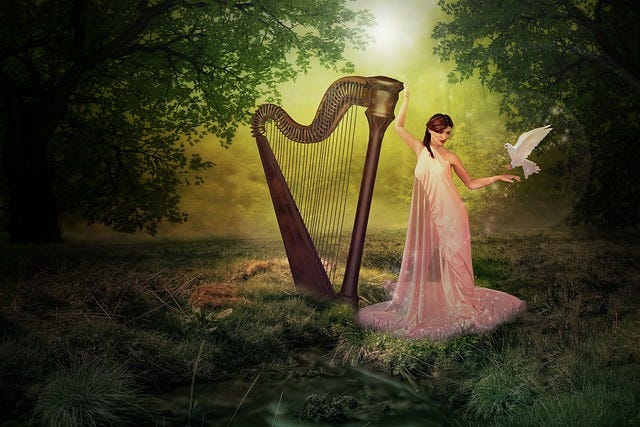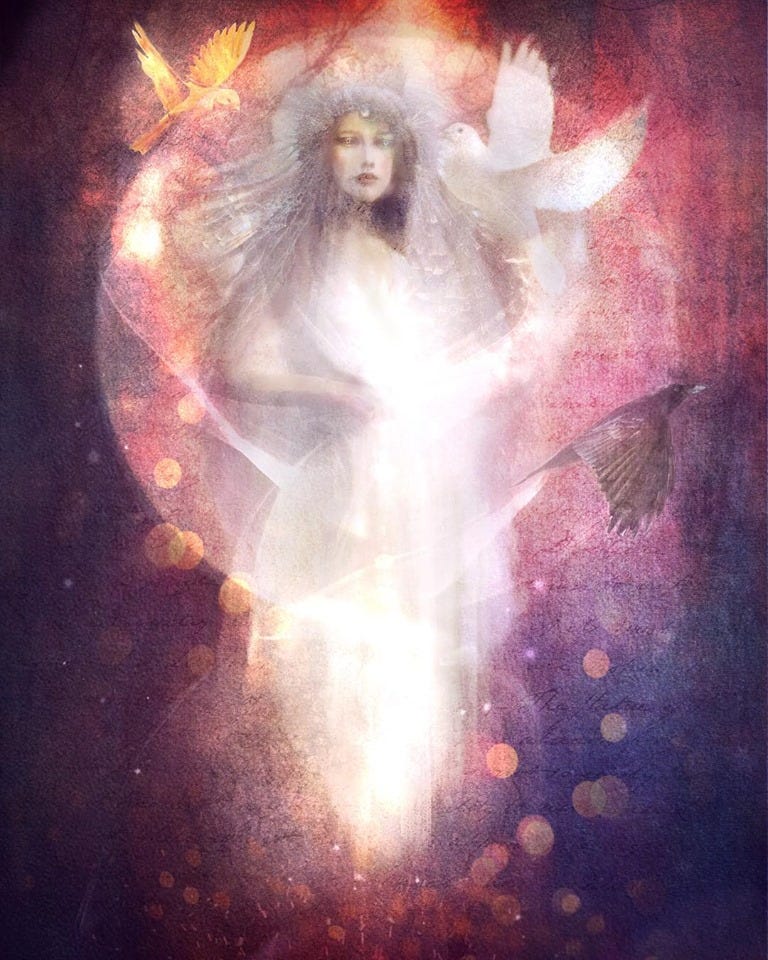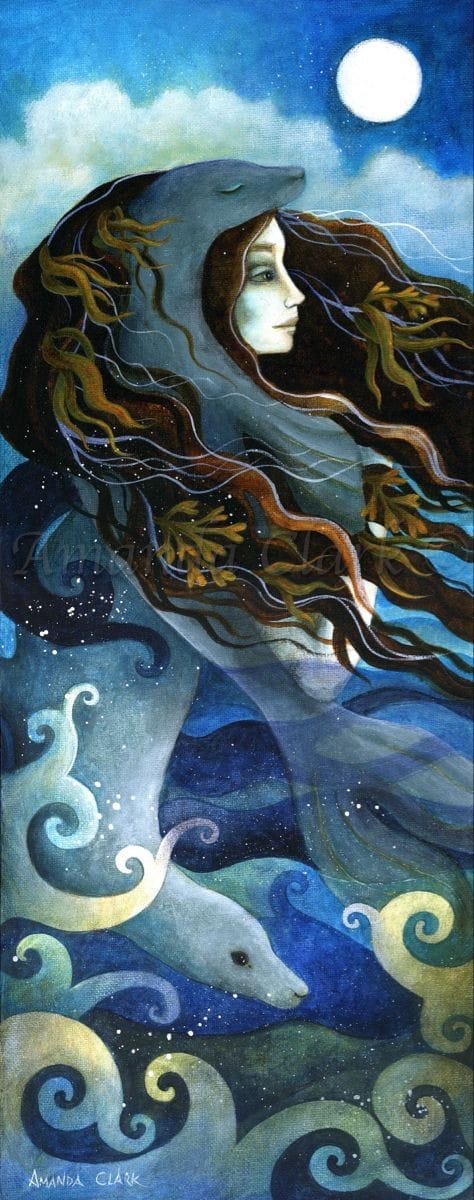Hello again,
Before I introduce you to Anwen of Glamorgan, I’d like to tell you about the year I began having downloads (muse-driven) of Bardic rhyming poems.
Those who’ve read my previous post know that I had not studied Celtic or Welsh mythology before I was given ‘the assignment’ to write the life story of a Druid Priestess. I thought the poetic style was a phase, brought on by the need for a poem I could recite at an Irish Night dinner party.
This event was one of the 4 international dinners I gave at my condo in Florida. Five friends, some meeting for the first time, sat around my circular table enjoying food, wine, and congenial conversation. Everything from before dinner drinks to dessert came from the cuisine of the ‘country of the night.’ We listened to the appropriate music. It was great fun, and invitations became sought after, so I had different mix of friends for each.
Along with the food and music, we did something appropriate to the culture in the time between dinner and desert. For Spanish night, we danced to Gypsy Kings. For Middle Eastern night, we tried some belly dance (not authentic, but the guys enjoyed it, nonetheless). And when Irish Night came along, we each had to sing a song, read a poem, or tell a story.
A few weeks before Irish Night, I had somehow been inspired to write a poem for a work colleague who was in love with a slightly younger man and in the throes of despair. As it came in, it surprised me by turning into a rhythmic, rhyming poem, eventually called Morgana’s Lament. I realized the setting and tone conjured a time far in the past, but I didn’t know why.
The poem began:
Beautiful boy, becoming a man
I know you’ll stay with me as long as you can.
I’ll turn down the lamplight to soften my face,
Removing the witness to Time and the traces
That tells us too long is the span of our ages….
It clearly had nothing to do with my friend’s situation with the young surfer, but when I read the finished poem to her, she cried. Performing this during my years of public poetry readings, inevitably a woman in the audience would come up to me to tell me how strongly she could relate.
But the realization that the lines of this poem are the story of a Priestess, initiating a young man in the arts of love, and unfortunately falling in love, didn’t take place until the Revealing the Druid Legacy trilogy was published.
When I told another friend that she and her boyfriend would be guests at Irish Night and what it entailed, she begged me to let her read Morgana’s Lament. I gave her my permission and a copy of the poem to practice. But now, what would I read?
One day, I remembered a poem I had started about ten years before, near the eve of my wedding. Some conflicts about going through with it were arising. Unable to sleep, I sat in my bedroom, looking out the window at a Full Moon. A poem started to form.
“Alone in my garden on Midsummer Eve
That night of Moon Magic, with quicksilver ease
I cast off forever the subtle, sweet, supplicant
Mask of my bondage to seek by release…”
The poem goes to a point where the speaker is wandering and finds herself “low in the lap of a valley, golden air thick with the humming of bees. Before me…….”
Try as I might, I just couldn’t see what came next. At first, I explored the idea of Demeter and Persephone. No, that was my mind and not the Muse, and so the storyline didn’t go on.
The poem remained unfinished for a decade, until I remembered the fragment and thought it might bring something for me to use at Irish Night. I wondered if the right goddess, for a goddess I knew it would be, would come to my mind.
When it did, the whole long, rhyming poem was downloaded within an hour. Eventually there would be a tune to go with the song this goddess sings. The name was Rhiannon.
Now, the only Rhiannon I knew of in 1993 was in the famous song by Steve Nicks*. I loved the song, but I had no idea who Rhiannon was, or what the lyrics meant. Still, this was the name, and so, on the poem went.
“Before me Rhiannon danced with her consort
I fell into rapture and sank to my knees.”
Rhiannon sings a song as “they danced in a circle, becoming a spiral,
their gaze never wavered, their movements as one.” In her song, a tale of love, pain, and forgiveness unfolds.
Then, “The melody faded, the memory lingered, my reverie deepened till all thought was gone. And when I awoke, a garden in sunlight. The birds and the butterflies told me, you’re home.” Speaking in the teller’s mind, the goddess delivers a powerful message. A lesson is learned, and at the end of Rhiannon’s Dance, her song is sung again by the teller, with a new coda.
The tune came the next day as I began to memorize the words. Reading and singing this at Irish Night created a profound experience for everyone. The husband of a friend who was first generation Irish was the most affected. He said I had even come up with a melody like songs from the Old Country.
Something beyond me was really going on there, and “Rhiannon’s Dance” would move many people at readings and later for readers of the volume of poetry that contains all the Bardic poems and others of varied forms and feelings, Journey to the Meaning of Love.
The third Bardic poem in the volume arose after a friend who loved Rhiannon’s Dance, sent a photo of her painting. Her image (not the one shown below) was a woman shapeshifting into a Selkie…the magical seal of folktales from the northern shores of the UK.
“Can you write a poem for this?” she asked. And again, a rhythmic, rhyming tale was delivered.
Selke begins:
“Cool, shimmering moonlight
Cast crescents of white
On the swells of the dark night sea
While a man on the shore
Stood mesmerized and more
By the sight and the sound of Selke,
By the beautiful, sad-eyed Selke.”
Decades later, when I had finished and published the series, I would finally realize these poems connected to novels, never dreamed about until the assignment from the stranger on the train to London in 1999.
While Morgana’s Lament would refer to an important service performed by Celtic and other Priestesses, the Selke would become a character in the Priestess Training. Rhiannon would be revealed by the need for authenticity.
Sometime around 2012, began receiving emails from Gwilym Morus-Baird, a Professor of Welsh History and Mythology. I then followed him at Celtic Source on Facebook and joined his group. I don’t remember how I came to know about him, but I took his course on the famous Bard, Taliesin.
Later, we studied the stories of the Goddesses in the first written Welsh mythology, The Mabinogion. Rhiannon is one of the ‘Sovereignty Goddesses’ and I discovered that in my poem, the tale in her song, and even the birds and butterflies, are a part of her myth and those ‘creatures of the air’ are associated with her, too.
When I sought his help with Welsh names for my characters, Gwilym said that the goddess names were not the ones of late 5th century CE, appearing in the fully Christianized anonymous telling of the myths, written in the 11th or 12th century.
As with all their wisdom, the Druids left no information to be distorted, and those early names are not known. Since I had vowed to stay true to the period of Anwen’s life, Rhiannon and the other Goddesses in the Mabinogion do not appear in the novels.
But the information about Welsh Goddesses and how they differ from those of the Celtic Druids in Anwen’s time was discussed in an interview I had with Karen Tate on her podcast, Voices of the Sacred Feminine. That will be a topic in another Moments in the Flow, once you have experienced a bit of the Goddess in Anwen’s world.
Voice Over Blues
I had tried a voice over for a post and found there was a problem with the speed in the recording, which suddenly began to accelerate. Another Substack writer told me that the program is having problems.
I will have to inquire to see if there is something that can be done because when I share excerpts from the book, I’d really like readers to be able hear them read aloud, as well as seeing them on the page. This is on my list of things to do!
See you next time!
Artist: opening photo: Simi on Pixabay
Artist for Selke is available on Etsy Amanda Clark
Taliesin Youtube link above: Gwilym Morus-Baird
Taliesin Origins, a well-told verions by Gwilym can be found HERE
Artist: Rhiannon: She Who Is
*I recently read that in 1972, Stevie Nicks had been reading a copy of The Mabinogion left on a coffee table at a friend’s home in California, and was inspired by this to write her song. That was early for the Welsh Myths to be known in the US.





As my divorce was finalizing from an abusive marriage, I got huge downloads of poetry about my emotions from all of those years which I was surpressed from feeling anything. I'd never written poetry before but now I have about 30 poems downloaded over a few months a couple of years ago. I think that I'm about ready to publish them next year. Thank you for sharing your process and letting me know I'm not the only one who gets these downloads out of the blue!
I love reading about your journeys and processes!
And I have been getting so much mileage from recording voiceovers via voice memo on iOS, if your a Mac user, and then uploading it.
I’m so glad to be in this community with you.